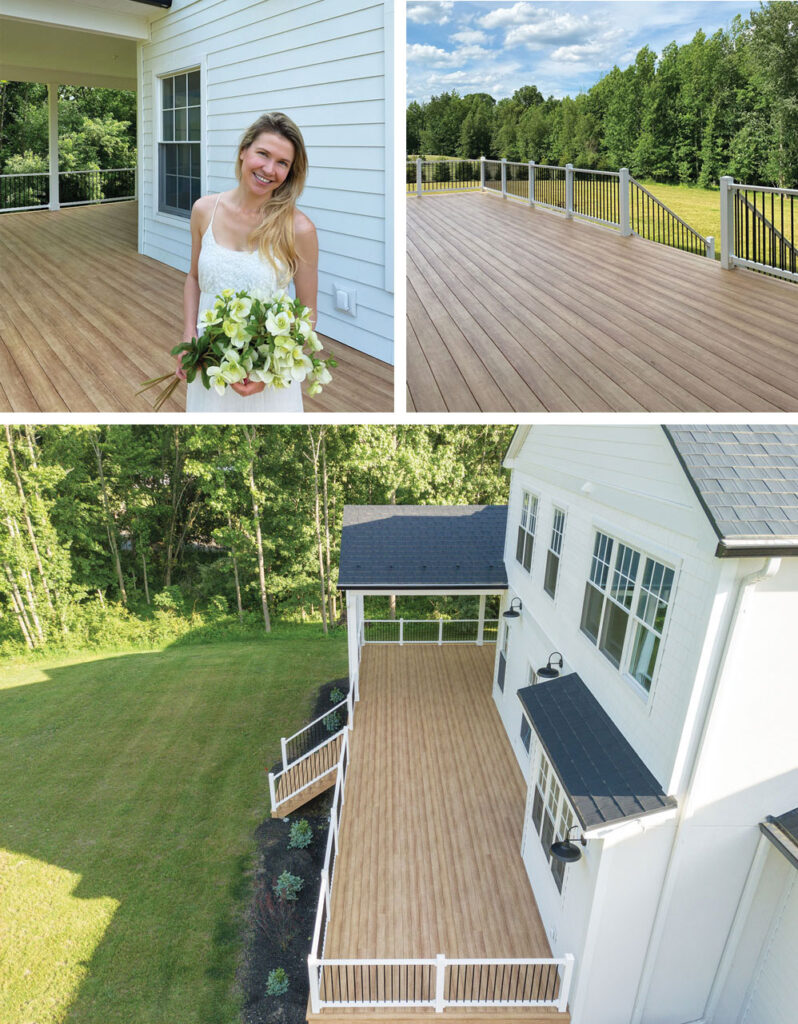On Deck
| Interview by Ren MillerA place to enjoy the outdoors come rain or shine
Decks and patios serve as a bridge between the house and the yard and, as such, deserve careful consideration. Kate Rumson explains how she planned the deck at the home she is building in central New Jersey. Kate is the founder and creative director of The Real Houses of Instagram (@the_real_houses_of_ig). Design NJ has been sharing updates on her new home in this column.

The wood-look decking creates visual warmth, while the black and white railing ties into the palette of the house and will accommodate a range of colors for outdoor furnishings. The covered portion at the far end of the deck will offer protection during inclement weather.
Ren: Our outdoor spaces play an increasingly important role in how we use our homes, and the options may seem endless. What did you consider when choosing a deck rather than a paver patio?
Kate: The topography of our site played a big role in the decision to go with a deck. The area where we built has a high groundwater table, so the house needed to be elevated about 5-6 feet off the ground. I didn’t want to have too many steps from our rear patio doors, and it was easier to build a deck vs. bringing in additional soil and building retaining walls for a paver patio, Plus, I love the warmth and coziness of a deck.
Ren: What material did you choose for your deck?
Kate: I chose Zuri® premium decking by Westlake Royal® Building Products because it was the only decking material that looked like real wood but that did not require the same maintenance. It’s made of a multilayer PVC material and is designed with the natural patterns and colors of exotic woods. The grain textures on Zuri do not repeat as in other composites, and the colors do not fade to gray as with real wood. I felt it was the perfect decking product that combined beauty and practicality.
Ren: What factors did you consider when choosing railing types and styles for your new deck?
Kate: The overall look and feel of the backyard were the most important factors. Glass or cable railings felt too modern for the aesthetic I was going for, wood railing would require too much maintenance, so I went for a classic black and white railing that works beautifully with the white siding and the black metal roof.
Ren: Will you have any covered space? If so, what are the advantages?
Kate: Yes, I’ve never had a covered outdoor space before and always wanted one! The idea of being able to spend time outside even when it’s raining always seemed magical to me, and I can’t wait to experience it in my own home.
Ren: You decided not to have a pool. Why is that?
Kate: I grew up in a house with a pool and we rarely used it. I remember my parents complaining about the maintenance and upkeep. Pools are beautiful to look at, but it’s not something my family would use often. Plus we would need to build a fence and hire someone to open/close and maintain the pool. We’d also have higher energy bills, property taxes and insurance. All of that would be worth it for someone who loves pools and sees themselves using it all summer long — I am not that person.
Ren: Should the front and back of a residential property have the same aesthetic or is it OK if they’re different because they are used differently?
Kate: I believe that all exterior finishes should work well together, but they don’t have to be all the same. I wanted a house with a formal facade but a casual backyard. We were able to achieve that aesthetic by using different materials and textures, but all in the same black and white color family. That is the beauty of building custom — there are no rules, anything is possible.
